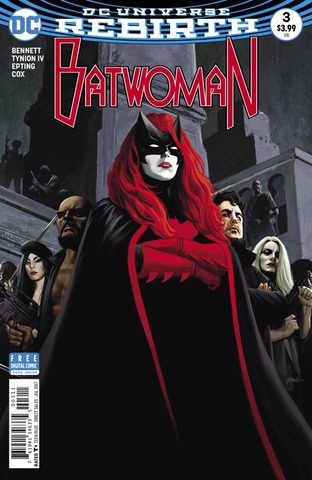I’m a fan of Batwoman in general: and of Batwoman comic books, which have a tendency to lend themselves to highly absorbing, stylised visual experiences as well as engaging detective stories.
I also would say that I’ve probably preferred for some years now to read Batwoman comics than to read Batman comics.
I didn’t get to posting anything on the Batwoman Rebirth comics a year or so ago: but having recently been re-reading some of those comics – particularly the ‘Many Arms of Death’ storyline, I was sufficiently impressed with them still to post up a review/recommendation.
I also want to take this moment to say that there needs to be a Batwoman movie – and it absolutely needs to be in the style of this comic book.
Batwoman Rebirth #1 does little more than set the stage, retelling and somewhat reimagining Batwoman’s history and origins. As those sorts of affairs go, this is a quality comic, enlivened by very lucid art and colors.
It feels partly cinematic and partly like a novel, which is a style that works very well here. An almost compulsory Batman cameo helps ground everything in the familiar, but this is a Kate Kane story all the way.
As a new start-point for the Batwoman mythology, Batwoman Rebirth #1 does a really solid job.
The cinematic quality is reinforced by the bucket-load with Batwoman #1 proper – Steve Epting’s cover alone is absolutely stunning. It looks like a retro film poster; and if I saw that poster in a cinema, I would absolutely want to be seeing this movie.
It really is an astonishingly good piece of cover art.
For that matter, J.G Jones’s variant cover is pretty damn good too.
The book doesn’t let the cover art down either. The international, jet-setting dynamic to the narrative helps put this book on a broad footing; it feels a tad like James Bond at moments (or perhaps more like something in the Black Widow/Natasha Romanov mold).
That’s not a criticism, however, as this book feels fresh and distinctive; and ‘The Many Arms of Death’ feels like something that should be adapted to cinema.
And here’s a serious point: with a Black Widow movie in the works in the Marvel Cinematic Universe, the DC Cinematic Universe really should consider a Batwoman movie in full-on film-noire mode.
They’ve already tried the more off-beat, stylistic effort in the form of Suicide Squad – which wasn’t a great movie. But a noire-style Batwoman movie could be the kind of dynamite the DC film franchise needs to reinvigorate itself.
Getting back to this book, who wouldn’t love the idea of Batwoman going on the hunt after white supremacist terrorists and ending up in a bazaar in Turkey? The present-day narrative is onto a winning thread, for sure; but the past-tense narrative is where the greater intrigue lies.
The artistic choice (albeit grounded in some older, classic Batwoman comics) to depict the past sequences in Sin City style black and white (except for Kate’s red hair) is a superb touch, which really amplifies the film-noire aesthetic that is clearly present in this book.

This is a story that moves slowly, carefully, like a good mystery thriller. And when it is done with this much style and distinctive flair, that’s no bad thing. The cinematic/noir approach to the story is absorbing; and if this series continues in this fashion, it’s going to be a fine, fine book.
Batwoman #2 continues on this form. The past-tense narrative – the ‘lost year’ in Coryana – helps frame the story in even more cinematic terms, while everything else continues to unfold like a tense film-noire, complete with moody tones, inner monologue, mounting mystery and veiled agendas and allegiances.
This unfolds, step by step, as a great mystery play, a detective story, with Kate slowly uncovering more and more of a grand conspiracy involving immoral corporations, criminal organisations and even the hint of an Illuminati-esque secret society element.
This would, again, make a great novel or movie. But what makes it a great comic book series is how sublimely it is married to the stunning visual presentation. The art throughout all these books is utterly perfect. It helps that Batwoman as a character lends herself so much to high-quality visuals; but, really, everything here is beautifully illustrated and coloured, from one knock-out item of cover art after another to the seamless flow of visual poetry from panel to panel.
‘The Many Arms of Death’ concludes in Batwoman #4, which, while just as visually stunning as all the other chapters, is probably a little less compelling in story terms. Even while ostensibly wrapping up this opening arc, however, it lays the seeds for the next mysteries and plot developments.
Batwoman #5 takes us more fully into the past-narrative story that was hinted at in previous issues, showing us more about Safiyah Sohail and Kate’s relationship, the Desert Rose, and other mysterious elements alluded to in the previous chapters. It’s essentially a prequel, and it works pretty well for what it sets out to do – although it is a lot less engaging as the previous chapters.
Still, Margaret Bennett and James Tinyon have given us a top-quality run of storytelling here, amplified by probably the finest, most stylistically-absorbing artwork I’ve seen in mainstream comic-books for a good while.
I highly recommend these comics (or the omnibus) for any fan of top-quality comic books, detective stories or – of course – Kate Kane in general.
With a mouth-watering new story direction coming up after this (with the ‘Pax Batmana’), it looks like things are going to get even better beyond this opening arc.
But I seriously want that Batwoman movie – it is exactly what the DC Cinematic Universe needs. And if they did do it, then this current run would provide more than adequate basis for cinematic adaptation.




